 Louisville Metro’s Office of Advanced Planning and Sustainability, the Louisville Sustainability Council, and the Louisville Zoo will co-host the sixth annual Sustainability Summit on Friday, Nov. 1.
Louisville Metro’s Office of Advanced Planning and Sustainability, the Louisville Sustainability Council, and the Louisville Zoo will co-host the sixth annual Sustainability Summit on Friday, Nov. 1.
“For all of us, as individuals, as organizations, as a community and a nation, reversing climate change has to be a factor in our decisions every single day,” said Mayor Greg Fischer, who declared a climate emergency during a local Global Climate Strike event in September. “Please join the 2019 Sustainability Summit to work with community leaders and stakeholders on ways we can take on climate change with a sense of urgency, purpose, and focus.”
The Summit will feature keynote speaker Dr. Robert Brinkmann, the vice provost for scholarship and research and director of sustainability studies at Hofstra University, as well as a panel of local leaders on tackling greenhouse gas emissions in Louisville.
“The summit is our annual opportunity to gather together under one roof as concerned individuals, nonprofit organizations, school groups, faith-based groups and sustainability professionals from the public and private sectors,” said Alicia Hullinger, Board Chair of the Louisville Sustainability Council. “It is a day for celebration, collaboration, and exploration that cannot be missed if you are concerned about creating a local climate action in Louisville.”
The keynote speaker, Dr. Brinkmann, is the author of several books and articles, including Introduction to Sustainability, the first major textbook on the topic. His new book, Environmental Sustainability in a Time of Change, will be published early next year. During his speech, he will present seven ways to advance your sustainability agenda in a time of change.
The Summit will also feature a panel of local leaders from Louisville Metro Government, TreesLouisville, Harshaw-Trane, and the NAACP Environmental and Climate Justice Programiscussing how their organizations are working to combat greenhouse gas emissions. Youth activism and performance group The Mighty Shades of Ebony also will debut their new song on climate change, titled “Anthropogenic.”
The Sustainability Summit is proud to receive support from Patron Sponsor Yum! Brands; Champion Sponsors Genentech, TARC, Humana, and PNC Bank; Summit Friend Sponsor CMTA; and Supporting Sponsors Harshaw Trane, K. Norman Berry Associates, Louisville Metro Air Pollution Control District, the Partnership for a Green City, WestRock, and Stantec.
The summit will take place from 3 to 7 p.m. on Friday, Nov. 1, at the Louisville Zoo. Tickets are available to Louisville Sustainability Council members for $45, to the general public for $60, and to college students with an ID for $30.
More information and registration can be found on the Louisville Sustainability Council website: http://louisvillesustainabilitycouncil.org/2019-sustainability-summit.
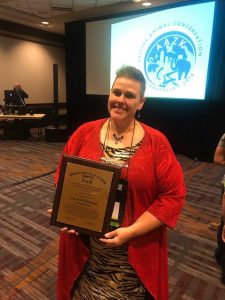 Louisville Zoo Keeper Alexis Williamson has been awarded the Lutz Ruhe Professional of the Year Award by the American Association of Zoo Keepers (AAZK). Williamson, who works in Gorilla Forest, was honored at the association’s national conference on Tuesday, Aug. 20 in Indianapolis.
Louisville Zoo Keeper Alexis Williamson has been awarded the Lutz Ruhe Professional of the Year Award by the American Association of Zoo Keepers (AAZK). Williamson, who works in Gorilla Forest, was honored at the association’s national conference on Tuesday, Aug. 20 in Indianapolis.
The Lutz Ruhe Professional of the Year award recognizes outstanding commitment to professionalism. Williamson’s conservation efforts were specifically noted which include contributions to Plinko for a Porpoise and the Zoo’s flagship Black-Footed Ferret Conservation Center as well as generational record contributions for the gorillas housed at the Louisville Zoo. In addition, she has been a vital part of the formation of the Animal Enrichment Tree Program at the Zoo while serving on the enrichment committee. Williamson has been president of the AAZK chapter at the Zoo for 14 years.
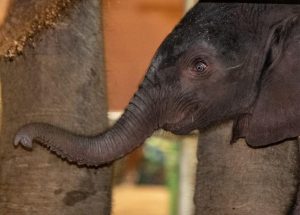
The Louisville Zoo’s 33-year-old African elephant, Mikki, gave birth to a male calf at 11:24 p.m. on Friday, August 2, 2019. It is only the second elephant born at the Louisville Zoo in the Zoo’s 50-year history.
During the calf’s birth, Mikki was attended to by the Zoo’s Animal Health Center and elephant keeper staffs as well as Dr. Dennis Schmitt, the leading North American expert in elephant reproductive physiology and veterinary management.
“Mikki did all the work. Her labor progressed nicely and without complications,” said Senior Veterinarian Dr. Zoli Gyimesi. “Mikki gave birth to a strong and vigorous bull calf.” According to Dr. Schmitt, “The delivery was textbook. All the staff, both elephant and veterinary staff knew their roles and performed them perfectly.”
Immediately after the birth, the veterinary team performed a neonatal exam.
The calf measures 98 cm tall, 77 cm long (body, head to tail) and 198 cm from the tip of his trunk to the tip off his tail. Mikki, calf and herd mate – Asian elephant Punch – will be off exhibit while the herd bonds. An announcement of a public debut will be made at a later date.
“It’s an exciting day at the Louisville Zoo,” said Louisville Zoo Director John Walczak. “We are so thrilled for Mikki and this calf. We are grateful to our community for embracing Mikki’s pregnancy and being a part of her journey. Raising a calf is one of the most enriching things an elephant can experience. I am very proud of our staff and the amazing job they did to ensure a smooth and safe pregnancy for Mikki and for the calf during birth.”
Mikki gave birth after nearly a 22-month gestation (651 days). She became pregnant through artificial insemination in October 2017 with the help of Dr. Schmitt. Mikki was carefully monitored and well cared for throughout her pregnancy. Staff worked hard to regulate Mikki’s diet and exercise her daily in order to minimize weight gain and get her fit for the delivery. Ultrasound exams and blood hormone monitoring were performed regularly to track the pregnancy.
The Association of Zoos and Aquariums’ (AZA) elephant breeding program is administered under the auspices of the Elephant Species Survival Plan (SSP), a cooperative program of all accredited zoos with elephants. The plan promotes the survival of elephant species into the future by providing linkages between zoo animal “ambassadors” and the conservation of their counterparts in the remnant wild.
“Elephant breeding at accredited zoos provides critical support for elephant conservation, said Walczak. “Every day, more and more habitats for wild animals are lost due to a growing human population, habitat destruction and poaching. The African elephant population has declined and we want to do our part to help with conservation efforts both locally and worldwide.”
To help the Zoo and the community celebrate the birth of this important elephant calf, the Zoo’s gracious partners at Churchill Downs (Twin Spires) and Louisville Waterfront Park (Big Four® Bridge) will light their iconic structures green. Beginning Monday, the Louisville Gas and Electric building’s green light will be in honor of the calf. Green will symbolize this calf’s significant birth as part of the world-wide conservation efforts on behalf of this magnificent and vulnerable species.
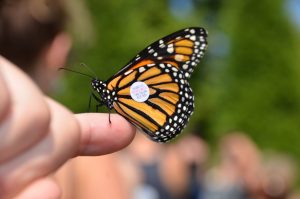 Butterflies n’ Blooms culminates with the tagging of over 1,000 monarch butterflies for release at Flutter Fest on Sept. 22 brought to you in partnership with Louisville’s Idlewild Butterfly Farm. This release coincides with the annual migration of monarch butterflies.
Butterflies n’ Blooms culminates with the tagging of over 1,000 monarch butterflies for release at Flutter Fest on Sept. 22 brought to you in partnership with Louisville’s Idlewild Butterfly Farm. This release coincides with the annual migration of monarch butterflies.
Activities starting at 10 a.m. will include:
- Craft and activity stations: Children of all ages can play games and make crafts while learning more about monarchs and their long journey.
- Education stations: Visit stations to learn the importance of pollinators and what you can do to help them.
- Storytime plus Meet and Greet The Very Hungry Caterpillar: Hear the beloved tale of a particularly hungry caterpillar and meet The Very Hungry Caterpillar.
- Butterfly Talks and Release: Join us at 2 p.m. as butterfly expert Blair Leano-Helvey gives a talk on the importance of pollinators like monarch butterflies. Then watch as the sky fills with butterflies during the release of over 1,000 tagged monarchs.
- Pollinator Parade: Kids can join our special pollinator parade following the butterfly release at 2 p.m. If you don’t have your own wings, our gift shop has butterfly wings available for purchase.
There will be special plant sales from our Butterfly partner, Idlewild Butterfly Farm.
The Louisville Zoo, a nonprofit organization and state zoo of Kentucky, is dedicated to bettering the bond between people and our planet by providing excellent care for animals, a great experience for visitors, and leadership in scientific research and conservation education. The Zoo is accredited by the American Alliance of Museums (AAM) and by the Association of Zoos and Aquariums (AZA).
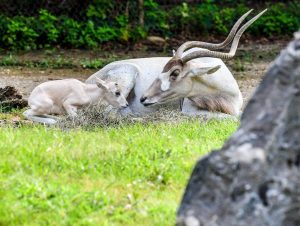 The Louisville Zoo welcomed a male Saharan addax calf born early morning Sunday, August 19. The mother is Patella and the father is Laird. The calf weighs a little over 18 lbs. This is the 59th calf born here at the Zoo. Addax have been a part of the Zoo since it opened in 1969.
The Louisville Zoo welcomed a male Saharan addax calf born early morning Sunday, August 19. The mother is Patella and the father is Laird. The calf weighs a little over 18 lbs. This is the 59th calf born here at the Zoo. Addax have been a part of the Zoo since it opened in 1969.
The International Union for Conservation of Nature cites the Saharan addax as critically endangered. In 2016, field researchers estimated that less than 100 individuals remain in the remnant wild.
The addax is found in arid regions of Africa, within isolated pockets of the Sahara desert. They live in small groups of five to 15 animals that are led by a mature male.
The new Louisville Zoo calf will join the other addax on exhibit daily in the yard located near the bongo and elephant exhibits in the African zone.
A name will be announced in the coming weeks.
This addax birth was planned and is a part of the Association of Zoos and Aquariums (AZA) Species Survival Plan (SSP). Breeding plans work to maintain the genetic diversity of managed animal populations.
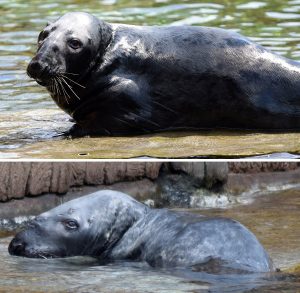 Boone and Minnow, two male gray seals, have joined the other pinnipeds on regular rotation at the Louisville Zoo’s Glacier Run exhibit. Both seals come to Louisville from Chicago’s Brookfield Zoo.
Boone and Minnow, two male gray seals, have joined the other pinnipeds on regular rotation at the Louisville Zoo’s Glacier Run exhibit. Both seals come to Louisville from Chicago’s Brookfield Zoo.
Minnow (bottom right), who is 31 years old, and Boone (top right),13, join California sea lions Triton (28), Bart (25), Gremlin (14), Riva (4), along with harbor seal Toney (16) and gray seal Rona (4) in the popular habitat.
The Louisville Zoo has a rich history with this species of animal. Eight seal pups have been born at the Zoo and when twin seal pups were born in 1979, they were the first twins to be documented in a managed system such as a Zoo.
Gray seals are natively found in temperate and subarctic waters on both sides of the North Atlantic. Seals have good senses to help them hunt. Their eyesight is excellent because of the time they spend underwater. Baby seals, called pups, are born with a soft, white hair coat called the lanugo. By the time they are weaned the lanugo is molted and the pups assume the adult coloration. Seal pups don’t swim until they have molted. Seal pups are weaned after nursing only four weeks during which they gain 100 pounds. Gray seals can sleep underwater for up to 30 minutes at a time. This species can be distinguished from harbor seals by their longer noses, wider set nostrils and size, which is approximately twice as large as harbor seals. They primarily eat fish.
The Louisville Zoo, a nonprofit organization and state zoo of Kentucky, is dedicated to bettering the bond between people and our planet by providing excellent care for animals, a great experience for visitors, and leadership in scientific research and conservation education. The Zoo is accredited by the American Alliance of Museums (AAM) and by the Association of Zoos and Aquariums (AZA).
You can visit the Louisville zoo at 1100 Trevilian Way. Gates are open 10am through 5pm until September 23. From September 23 through March 15, gates are open 10am to 4pm.
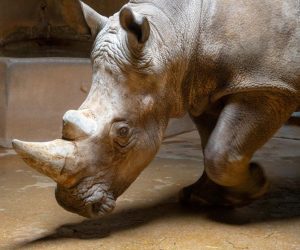 Meet Letterman — a new 3-year-old male southern white rhinoceros comes to the Louisville Zoo from The Wilds in southeast Ohio. The rhino was named by Jack Hanna after the late night television host and comedian David Letterman. Letterman was born on November 12, 2014 at The Wilds.
Meet Letterman — a new 3-year-old male southern white rhinoceros comes to the Louisville Zoo from The Wilds in southeast Ohio. The rhino was named by Jack Hanna after the late night television host and comedian David Letterman. Letterman was born on November 12, 2014 at The Wilds.
Letterman has completed his standard 30-day quarantine and will soon join 34-year-old female Sindi in the exhibit. As with any new animal introductions, the rhinos will be monitored. Introductions of unfamiliar rhinos can often result in sparring from both males and females, which is normal behavior. These normal interactions and dynamics in a rhino group can occasionally result in a superficial injury. The rhinos are regularly evaluated by the Zoo’s veterinary staff and any observed injuries are treated under their expert care. Once the rhinos are familiar with each other and their roles are established, they will usually engage in calmer interactions.
White rhinoceros are the largest land mammal after the elephant and the largest species of rhinoceros. Their range is southern Africa. The typical weight of a white rhinoceros is between 4,000 and 6,000 pounds. Adult white rhinos have no natural predators, other than humans, due to their size. White rhinoceros are listed as near threatened on the IUCN Red List of Threatened Species due to the continued poaching threat and increasing illegal demand for horns.
 Weather
Weather Traffic
Traffic @LouisvilleDispatch
@LouisvilleDispatch @LouisvilleDisp
@LouisvilleDisp Subscribe
Subscribe